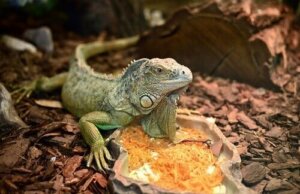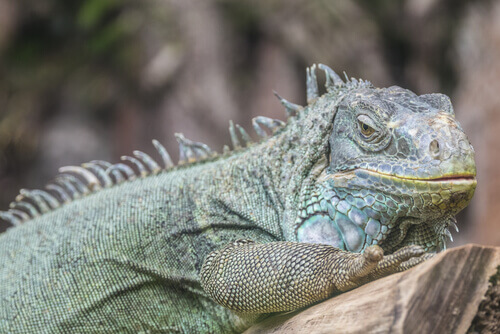Life Cycle of Iguanas: Their Behavior and Habits

For a few years now more and more people have been adopting iguanas as pets. To take care of them correctly, you need to know about the life cycle of iguanas and their behavior. Interested in learning more?
Life cycle of iguanas
You may already know that iguanas live and reproduce naturally in the Americas. They can measure up to seven feet in length and reach sexual maturity at 16 months. Ancient Mexicans and indigenous tribes saw them as a kind of god of fertility and virility, and ate them regularly. As a result, many countries in Central and South America consume them as a delicacy to this day.
Reproduction
Iguanas lay eggs between 50 and 100 days after copulation. Before laying her eggs, the female stops eating, but not drinking—her water intake actually increases. This provides optimal conditions for laying eggs, as she can accelerate or delay gestation depending on humidity and other factors.
These lizards prefer to live in trees, but they’re not the ideal place for laying eggs. Although iguanas are home high up in trees, on land or in the sea, they need a quiet place to lay their eggs, safe from humans and other predators.

For this reason, they’ll often swim great distances (when this is possible) in order to find deserted islands or small pieces of land on which to dig the holes for their eggs.
After digging holes in the selected area, they lay their eggs and bury them, hidden from the view of possible aggressors. Iguanas can lay up to 40 eggs in a single clutch.
Life cycle of iguanas: incubation
Iguana’s don’t incubate their eggs, because when they’re buried they’re already at the mercy of environmental conditions such as humidity, and the heat which the soil absorbs from the sun. This means that the eggs develop on their own without the help of the mother.
Curiously, the mother leaves once she has laid the eggs and breaks any connection or blood ties with her offspring. The baby iguanas hatch by themselves, although it can take them up to a day to adapt as they poke their heads out into the world.
Iguana behavior
Now that you know how iguanas reproduce and incubate their eggs, you’ll probably be interested in learning a little about their day to day behavior, especially if you’re thinking of getting one as a pet.

Iguanas are known for their aggressive character. In addition, this behavior intensifies during mating season, when the males fight over females; this includes whistling, making their bodies swell up, and inflating their chins.
During this time, they may even flick their tails against the wall of their aquarium until the tail breaks. Don’t worry; it’ll grow back. However, be careful when changing their feeder or water bottle because they can bite.
Iguanas’ mouths and tails are the main weapons they use to defend themselves. They use them if they feel cornered or attacked.
To sum up, if you’re thinking of getting an iguana, keep in mind that they aren’t the kind of pet you can sit with on the couch while watching a movie. Understanding their habits and behavior will help you give them the care and attention they deserve.
For a few years now more and more people have been adopting iguanas as pets. To take care of them correctly, you need to know about the life cycle of iguanas and their behavior. Interested in learning more?
Life cycle of iguanas
You may already know that iguanas live and reproduce naturally in the Americas. They can measure up to seven feet in length and reach sexual maturity at 16 months. Ancient Mexicans and indigenous tribes saw them as a kind of god of fertility and virility, and ate them regularly. As a result, many countries in Central and South America consume them as a delicacy to this day.
Reproduction
Iguanas lay eggs between 50 and 100 days after copulation. Before laying her eggs, the female stops eating, but not drinking—her water intake actually increases. This provides optimal conditions for laying eggs, as she can accelerate or delay gestation depending on humidity and other factors.
These lizards prefer to live in trees, but they’re not the ideal place for laying eggs. Although iguanas are home high up in trees, on land or in the sea, they need a quiet place to lay their eggs, safe from humans and other predators.

For this reason, they’ll often swim great distances (when this is possible) in order to find deserted islands or small pieces of land on which to dig the holes for their eggs.
After digging holes in the selected area, they lay their eggs and bury them, hidden from the view of possible aggressors. Iguanas can lay up to 40 eggs in a single clutch.
Life cycle of iguanas: incubation
Iguana’s don’t incubate their eggs, because when they’re buried they’re already at the mercy of environmental conditions such as humidity, and the heat which the soil absorbs from the sun. This means that the eggs develop on their own without the help of the mother.
Curiously, the mother leaves once she has laid the eggs and breaks any connection or blood ties with her offspring. The baby iguanas hatch by themselves, although it can take them up to a day to adapt as they poke their heads out into the world.
Iguana behavior
Now that you know how iguanas reproduce and incubate their eggs, you’ll probably be interested in learning a little about their day to day behavior, especially if you’re thinking of getting one as a pet.

Iguanas are known for their aggressive character. In addition, this behavior intensifies during mating season, when the males fight over females; this includes whistling, making their bodies swell up, and inflating their chins.
During this time, they may even flick their tails against the wall of their aquarium until the tail breaks. Don’t worry; it’ll grow back. However, be careful when changing their feeder or water bottle because they can bite.
Iguanas’ mouths and tails are the main weapons they use to defend themselves. They use them if they feel cornered or attacked.
To sum up, if you’re thinking of getting an iguana, keep in mind that they aren’t the kind of pet you can sit with on the couch while watching a movie. Understanding their habits and behavior will help you give them the care and attention they deserve.
This text is provided for informational purposes only and does not replace consultation with a professional. If in doubt, consult your specialist.








